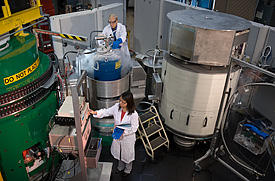FY2009: NIST Center for Neutron Research (NCNR) Expansion and Reliability Improvements
(+$2 million)
Challenge

Serving more scientists and engineers (over 2,000 annually) than all other U.S. neutron research facilities combined, the NIST Center for Neutron Research (NCNR) is the nation's leading neutron facility. The NCNR is especially valued for its "cold" (low-energy) neutron source, which greatly increases the utility of the neutron beam, particularly in biotech and materials research.
Although the NCNR is widely regarded as the most cost-effective and efficiently managed neutron facility in the United States, presently this critical research tool cannot possibly meet the demands placed on it.
Proposed NIST Program
This is a planned increase in funding for the NCNR Expansion Initiative, begun in 2007. When completed, this five-year project will provide:
-
a new generation of world-class cold neutron instruments directly supporting the needs of science and industry;
-
more than a 25 percent increase in the overall measurement capacity;
-
the ability to serve at least 500 additional researchers each year; and
-
increased operational efficiency.
The FY 2009 funding request supports the next phase of the NCNR expansion to initiate installation, testing, and commissioning of the new neutron instruments (such as spectrometers). These instruments will bring new neutron measurement capability to U.S. researchers by either exceeding the capabilities of current instruments by more than a factor of a hundred, or by providing capabilities that are not currently available in the United States.
In FY 2009, the project will focus on:
- installation of new neutron spectrometers and neutron beamlines;
- modification of beamlines and beamline shielding;
- modification of some existing instruments affected by new beamlines; and
- testing of new beamlines and instruments.
Expected Impacts
Completion of the NCNR expansion will allow:
- a new generation of world-class instruments directly supporting the needs of science and industry;
- an increase in the overall measurement capacity of the NCNR by more than 25 percent;
- the ability to serve at least 500 additional researchers each year; and
- increased operational effectiveness.

